

Indigenous peoples of the Northeastern Woodlands. Algonquian languages. The Algonquian languages (/ælˈɡɒŋkwiən/ or /ælˈɡɒŋkiən/;[2] also Algonkian) are a subfamily of Native American languages which includes most of the languages in the Algic language family.
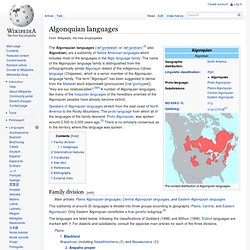
The name of the Algonquian language family is distinguished from the orthographically similar Algonquin dialect of the indigenous Ojibwe language (Chippewa), which is a senior member of the Algonquian language family. The term "Algonquin" has been suggested to derive from the Maliseet word elakómkwik (pronounced [ɛlæˈɡomoɡwik]), "they are our relatives/allies". A number of Algonquian languages, like many of the Iroquoian languages of the hereditary enemies of the Algonquian peoples have already become extinct. Speakers of Algonquian languages stretch from the east coast of North America to the Rocky Mountains. Algonquin people. Pre-contact distribution of Algonquian languages The Algonquian are one of the most populous and widespread North American native language groups, with tribes originally numbering in the hundreds.
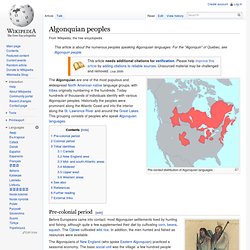
Today hundreds of thousands of individuals identify with various Algonquian peoples. Historically the peoples were prominent along the Atlantic Coast and into the interior along the St. Lawrence River and around the Great Lakes. This grouping consists of peoples who speak Algonquian languages. Pre-colonial period[edit] Algonquian couple, 18th-century A 16th-century sketch of the Algonquian village of Pomeiock. The Algonquians of New England (who spoke Eastern Algonquian) practiced a seasonal economy. In warm weather, they constructed light wigwams for portability.
From April through October, natives hunted migratory birds and their eggs: Canada geese, brant, mourning doves and others. Even with mobile crop rotation, southern villages were necessarily less mobile than northern. Navajo people. The Navajo (Navajo: Diné or Naabeehó) of the Southwestern United States are the largest federally recognized tribe of the United States of America with 300,048 enrolled tribal members.[1][2] The Navajo Nation constitutes an independent governmental body, which manages the Navajo Indian reservation in the Four Corners area of the United States.
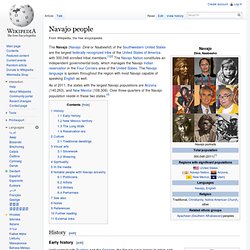
The Navajo language is spoken throughout the region with most Navajo capable of speaking English as well. As of 2011, the states with the largest Navajo populations are Arizona (140,263), and New Mexico (108,306). Over three-quarters of the Navajo population reside in these two states.[3] History[edit] Early history[edit] 19th-century hogan Navajo spinning and weaving The Navajo are speakers of a Na-Dené Southern Athabaskan languages known as Diné bizaad (lit.
New Mexico territory[edit] The Navajo came into official contact with the United States of America in 1846, when General Stephen W. In 1861, Brigadier-General James H. Navajo-nsn.gov. Apache. Apache (/əˈpætʃiː/; French: [a.paʃ]) is the collective term for several culturally related groups of Native Americans in the United States originally from the Southwest United States.
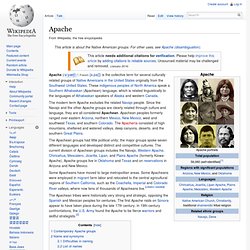
These indigenous peoples of North America speak a Southern Athabaskan (Apachean) language, which is related linguistically to the languages of Athabaskan speakers of Alaska and western Canada. The modern term Apache excludes the related Navajo people. Since the Navajo and the other Apache groups are clearly related through culture and language, they are all considered Apachean. Apachean peoples formerly ranged over eastern Arizona, northern Mexico, New Mexico, west and southwest Texas, and southern Colorado. Pueblo. Pueblos are modern and old communities of Native Americans in the Southwestern United States of America.
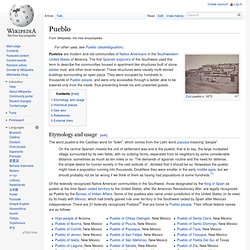
The first Spanish explorers of the Southwest used this term to describe the communities housed in apartment-like structures built of stone, adobe mud, and other local material. These structures were usually multi-storied buildings surrounding an open plaza. They were occupied by hundreds to thousands of Pueblo people, and were only accessible through a ladder able to be lowered only from the inside, thus preventing break-ins and unwanted guests. Etymology and usage[edit] Ancient Pueblo Peoples. Ancient Pueblo peoples or Ancestral Pueblo peoples were an ancient Native American culture centered on the present-day Four Corners area of the United States, comprising southern Utah, northeastern Arizona, northern New Mexico, and southwestern Colorado.[1] They lived in a range of structures, including pit houses, pueblos, and cliff dwellings designed so that they could lift entry ladders during enemy attacks, which provided security.
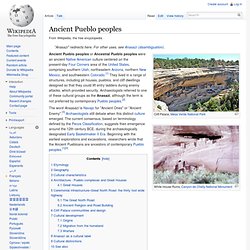
Archaeologists referred to one of these cultural groups as the Anasazi, although the term is not preferred by contemporary Pueblo peoples.[2] The word Anaasází is Navajo for "Ancient Ones" or "Ancient Enemy".[3] Archaeologists still debate when this distinct culture emerged. Inuit. Mound builder (people) Since the 19th century, the prevailing scholarly consensus has been that the mounds were constructed by indigenous peoples of the Americas.
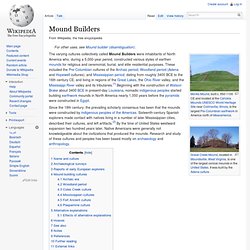
Sixteenth-century Spanish explorers made contact with natives living in a number of later Mississippian cities, described their cultures, and left artifacts.[2] By the time of United States westward expansion two hundred years later, Native Americans were generally not knowledgeable about the civilizations that produced the mounds. Research and study of these cultures and peoples has been based mostly on archaeology and anthropology. Name and culture[edit] At one time, the term "mound builder" was applied to the people believed to have constructed these earthworks. [citation needed] In the 16th through 19th centuries, Europeans and Americans generally thought that a people other than one related to the historic Native Americans had built the mounds.
Archaeological surveys[edit]